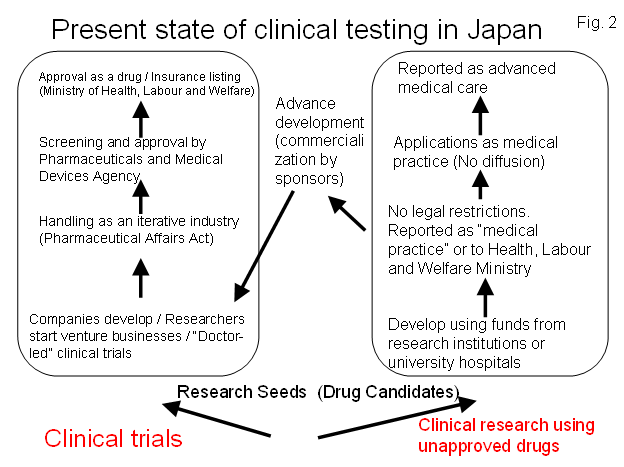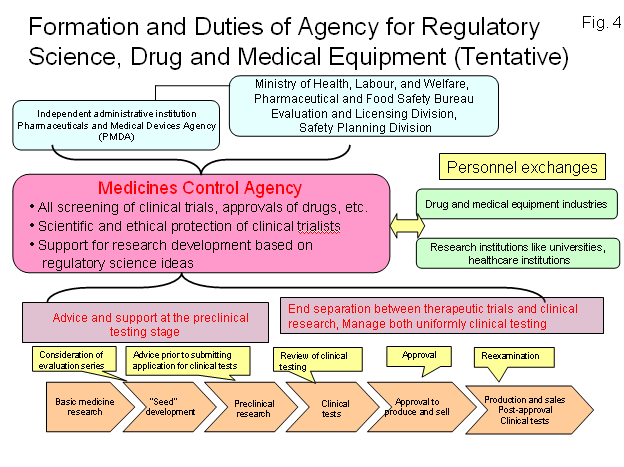1. Global Expectations for Healthcare Development and the Healthcare Industry
Maintaining and improving human health and fighting disease and illness are understood by people all over the world to be matters of vital importance. In his speech on April 27, 2009 to the National Academy of Sciences, U.S. President Barack Obama announced the U.S. would devote more than 3% of its GDP to research and development, a renewed commitment to education in mathematics and science, a budget increase for the National Institute of Health (NIH), and further investments in cancer research. This trend is not limited to the U.S. In Great Britain, government and industry are investing considerably in pharmaceutical products and in the development of medical instruments. These efforts are expected to bear good results (Figure 1).
Furthermore, attention is not limited to medical treatment; health maintenance and healthcare are also receiving more attention. However it is a concern that Japanese superior core technologies are not playing a leading role in pharmaceutical products and the medical equipment industries. This problem has not been caused by a lack of basic research or the ability and efforts of healthcare professionals. Rather, present regulations and restrictions are out-of-date and do not support international innovation strategies. In addition to this, another cause is the fact that the healthcare field lacks sufficient cross-disciplinary research in the areas of policy-making, administration, and systems research that will lead to the creation of proposals and recommendations.
2. The present state of Japan's medical equipment industry
The laws in Japan that regulate how pharmaceutical companies manufacture, sell, and distribute drugs do not make it easy for companies to introduce the results of new scientific technologies into their products. Since Japan does not have an integrated system of clinical research and clinical trials such as the Investigational New Drug (IND) system in the U.S., it is difficult to apply new technologies in the medical field (Figure 2).
 |
| Fig. 2 |
Medical equipment development in Japan occurs within the constraints of the Pharmaceutical Affairs Act. Unfortunately, this act was written with drug regulation in mind, and so is not easily applied to the regulation of medical equipment. Also, since the Government’s official announcement of Medical Device GCP (Good Clinical Practice), it has become difficult for companies to use prototypes of their medical equipment to conduct clinical research at universities. Clinical trials of medical equipment are influenced by the experience and skill of the administering doctor and by the level of the healthcare facility. Furthermore, there is a learning curve involved in becoming proficient at properly using medical equipment that varies from doctor to doctor. This means that it is indispensable that clinical research be conducted in a trial and error fashion using prototypes. In the U.S., the Investigational Device Exemptions (IDE) regulation supports clinical research and trials by using prototypesin clinical research. In Europe, though the EC Clinical Trials Directive came into effect in 2004 and served to integrate clinical trials and clinical research of drugs, clinical research of medical equipment continues based on each nation’s way of thinking about regulations. In Japan, it is said that a combination of slow screening of therapeutic equipment (controlled medical devices) by governmental authorities and regulations on clinical trials using medical equipment has resulted in a lack of clarity regarding strategy for the development of medical equipment.
Within the regulatory environment described above, even if a medical device has a truly “novel” feature it is difficult at the time of insurance price listing to assign the same treatment points as would be assigned to a medical device with a similarly intended purpose. This means that the motivation within the medical equipment industry to take up new challenges and development is low and that, furthermore, chances for innovation to occur in the medical and health fields decrease. Putting insurance matters aside, we must at least make reforming the regulatory environment a high priority. Below, I describe two related solutions.
3. Establishment of a Clinical Research “Control Tower”
To promote scientific and technological research, the Ministry of Education, Culture, Sports, Science and Technology allocates budgets to universities and other research institutions, and the Ministry of Economy, Trade and Industry supports companies and research institutes that are expected to contribute to industrial developments. In the healthcare field, however, unless the Ministry of Health,Labour and Welfare, as the regulating authority, promptly conducts screenings and approvals, technology and research is never able to contribute to society. Because of this, in July 2008, upon the recommendation of groups like the Japan Science and Technology Agency - Center for Research and Development Strategy (JST-CRDS), an independent administrative agency, the Cabinet Office established the Health Research Promotion Committee (Figure 3). This Committee is made up of the Ministers of the three agencies noted above, the Minister of State for Science and Technology Policy, and five Diet members on the Council for Science and Technology Policy, Cabinet Office. The Cabinet Office coordinates between the three agencies and the Committee seeks to promote healthcare development as a kind of “Clinical Research Control Tower." The first matter for cooperation between the three agencies was to invite and adopt proposals for research grants and to begin healthcare development centered on matters such as pharmaceutical aid. An Advisory Council has also now been established within the Health Research Promotion Committee to discuss the issue of how the nation should proceed forward with the important task of healthcare development.
4. Establishment of an Agency for Regulatory Science、Drug and Medical Equipment
The field of regulatory science focuses on ensuring the appropriate and safe use of substances that affect the human body - drugs, food, and other environmental substances - through laboratory research (wet research), sociological and epidemiology research (dry research), and clinical research. This research looks at issues such as standardization levels, safeness, efficacy evaluation, handling, and, at a higher level, administrative policy and the role of systems and structures. Therefore, it is important to provide feedback on accurate findings to influence administration policy and society. Though one might have the impression from the literal translation into Japanese of “regulatory science” that it is “a science of regulations,”andthat regulating results lessens the possibility for innovation, you would be quite mistaken. For example, in regenerative medicine when a highly “novel” cell is used in applied therapy, it is not known if the cell will actually form in the intended organ or turn cancerous. The risks of infection are also not known. Unless these potentially grave matters are accounted for, it is impossible for regulating authorities to grant their approval. For this reason, at each level of research development evaluation systems need to be built along the same axes and we need to acquire information regarding safety from studies of laboratory animals and clinical trial data. These scientific results must then be reflected in policy and regulatory guidelines. Making sure the approval process moves quickly is also something promoted internationally. Unless Japan understands the true importance of regulatory science and promotes it in industry, government, and academia, even when Japan has superior research, the amount of time it takes to apply the research in the real world will result in our losing out in the international playing field.
As described above, both clinical testing and clinical applications involve complicated dealings with the government along with complicated procedures. It is believed that in order to accelerate these processes, Japan needs a reform that includes a drastic rethinking and strengthening of approval administration (or, alternatively, the creation of a Japan-style FDA) (Fig. 4). More specifically, it is desired that the national approach taken by government agencies will be to have scientifically-sound goals for medical care, medicine, and industry, to centrally manage reviews and approvals of medical products by means of the clinical testing IND/IDE applications and review process, and to provide strong support for early-stage research and medical equipment development based on a solid understanding of regulatory science. We should do away with the separation between clinical research and clinical trials for unapproved drugs and consolidate the process by making clinical trials the essence of clinical research; regulatory agencies need to provide full support for screening and development to both companies and academic institutions by strengthening personnel and systems.
 |
| Fig. 4 |
5. Conclusion
In addition to the two proposals for reform noted above and for discussions concerning the insurance system, it is also important to consider the problem of how the Japanese people value health and whether they understand and support communicating to the world about Japan’s healthcare development and healthcare industry. It is necessary for the media to understand this point well and to continue educational activities.
|

